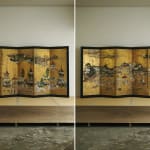Scenes from Gion Festival and Sanja Festival
Color and gold on paper, a pair of folding screens
Early Edo period
137 x 327 cm each (overall)
Further images
The Gion Festival is represented, featuring the procession of floats, in one of this pair of folding screens. Although no famous temple or shrine is visible, a small torii Shinto shrine gate is depicted on the left side of the screen. In front of the gate, four men are carrying out the shimenawa-kiri (cutting the sacred rope) ritual. One man is just throwing a long sword to cut the sacred rope stretched between two bamboo poles. This ritual, now carried out by a boy on the Naginata float in the Shijo street, seems to have been performed on the ground by several men with long swords during the Edo period, as shown here.
Depicted on the other screen is the procession of the Sanja Festival. Mount Fuji, though incorrectly located, indicates the scene is in Edo (the modern-day Tokyo). The river is the Sumida River and the Buddhist hall on the bank is Komagata-do. Along the river the procession is returning to the shrine, situated in the Senso-ji Temple. (They have been separated after the Meiji Restoration.) Sanja Festival is depicted in Edo meisho-zu byobu in the Idemitsu Museum collection, painted in the middle of the seventeenth century, in which the procession is coming back from the Asakusa-bashi bridge.
The painter is probably a machi-eshi (non-governmental painters), active in the latter half of the seventeenth century. He is excellent in the treatment of various poses, gestures of people, and horses.
Depicted on the other screen is the procession of the Sanja Festival. Mount Fuji, though incorrectly located, indicates the scene is in Edo (the modern-day Tokyo). The river is the Sumida River and the Buddhist hall on the bank is Komagata-do. Along the river the procession is returning to the shrine, situated in the Senso-ji Temple. (They have been separated after the Meiji Restoration.) Sanja Festival is depicted in Edo meisho-zu byobu in the Idemitsu Museum collection, painted in the middle of the seventeenth century, in which the procession is coming back from the Asakusa-bashi bridge.
The painter is probably a machi-eshi (non-governmental painters), active in the latter half of the seventeenth century. He is excellent in the treatment of various poses, gestures of people, and horses.







